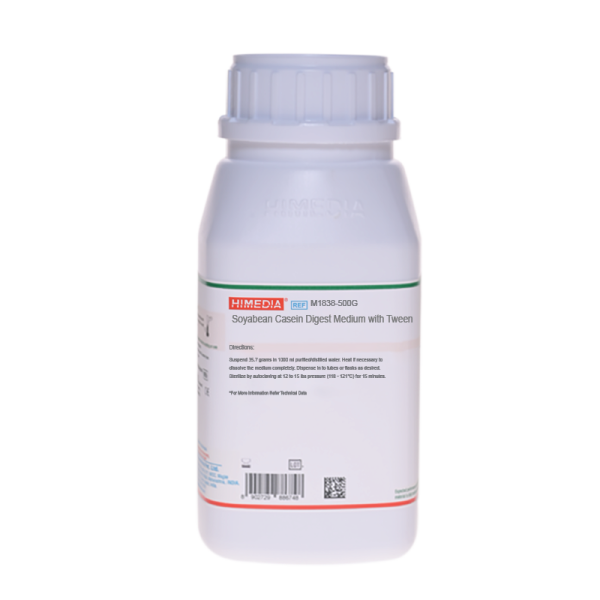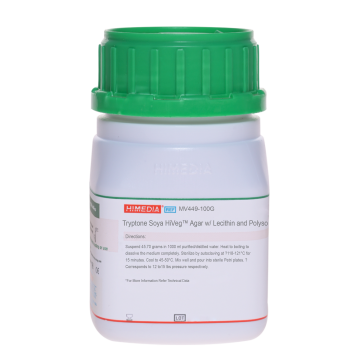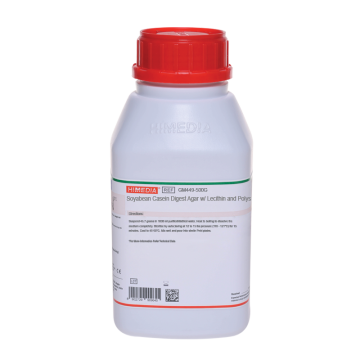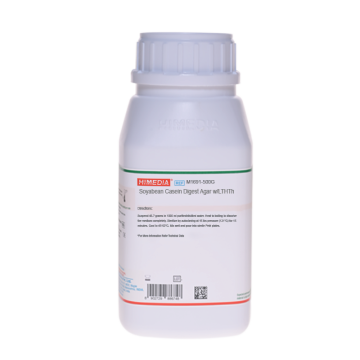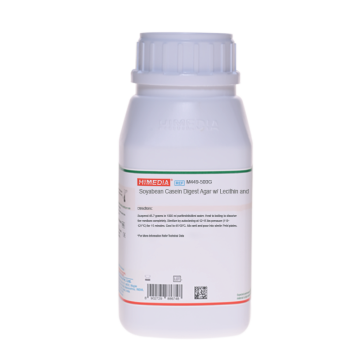 Your enquiry has been submitted
Your enquiry has been submitted
Soyabean Casein Digest Medium w/ Tween 80 and Lecithin
Intended Use
Recommended for determining efficiency of sanitization of containers, equipment surfaces, water miscible cosmetics etc.
Composition**
| Ingredients | Gms / Litre |
|---|---|
| Tryptone | 17.000 |
| Soya peptone | 3.000 |
| Sodium chloride | 5.000 |
| Dipotassium hydrogen phosphate | 2.500 |
| Dextrose(Glucose) | 2.500 |
| Lecithin | 0.700 |
| Polysorbate 80 (Tween 80) | 5.000 |
Final pH ( at 25°C) 7.3±0.2
**Formula adjusted, standardized to suit performance parameters
Directions
Suspend 35.7 grams in 1000 ml purified / distilled water.Heat if necessary to dissolve the medium completely. Dispense into tubes or flasks as desired.Sterilize by autoclaving at 12 to 15 lbs pressure (118 - 121°C respectively) for 15 minutes.
Principle And Interpretation
Soyabean Casein Digest Medium with Lecithin for the detection and enumeration of microorganisms present on surfaces of sanitary importances (6,8). Tryptone and Soya peptone provide nitrogenous, carbonaceous compounds, long chain amino acids and other nutrients essential for microbial replication. Lecithin and polysorbate 80 (Tween 80) are neutralizers reported to inactivate residual disinfectants from where the sample is collected (1). Lecithin neutralizes quaternary ammonium compounds and polysorbate 80 neutralizes phenolic disinfectants, hexachlorophene, formalin and with lecithin ethanol (2). Collection of samples from areas before and after the treatment with disinfectant evaluates cleaning procedures in environmental sanitation.
Type of specimen
Environmental samples
Specimen Collection and Handling
For Environmental samples follow appropriate techniques for handling specimens as per established guidelines (3). After use, contaminated materials must be sterilized by autoclaving before discarding.
Warning and Precautions
Read the label before opening the container. Wear protective gloves/protective clothing/eye protection/ face protection. Follow good microbiological lab practices while handling specimens and culture. Standard precautions as per established guidelines should be followed while handling specimens. Safety guidelines may be referred in individual safety data sheets.
Limitations
- This medium is general purpose medium and may not support the growth of fastidious organisms.
Performance and Evaluation
Performance of the medium is expected when used as per the direction on the label within the expiry period when stored at recommended temperature.
Quality Control
Appearance Cream to yellow homogeneous free flowing powder
Colour and Clarity of prepared medium Light yellow coloured clear to slightly opalescent solution without any precipitate.
Reaction Reaction of 3.57% w/v aqueous solution at 25°C pH : 7.3±0.2
pH 7.10-7.50
Cultural Response Cultural characteristics observed after an incubation at 30-35°C for 18-24hrs.
| Organism | Inoculum (CFU) | Growth |
|---|---|---|
| Staphylococcus aureus subsp aureus ATCC 6538 (00032*) | 50 -100 | luxuriant |
| Staphylococcus aureus subsp aureus ATCC 25923 (00034*) | 50 -100 | luxuriant |
| Escherichia coli ATCC 8739 (00012*) | 50 -100 | luxuriant |
| Escherichia coli ATCC 25922 (00013*) | 50 -100 | luxuriant |
| Escherichia coli NCTC 9002 | 50 -100 | luxuriant |
| Pseudomonas aeruginosa ATCC 9027 (00026*) | 50 -100 | luxuriant |
| Pseudomonas aeruginosa ATCC 27853 (00025*) | 50 -100 | luxuriant |
Key : (*) Corresponding WDCM numbers.
Storage and Shelf Life
Store between 10-30°C in a tightly closed container and the prepared medium at 15-25°C. Use before expiry date on the label. On opening, product should be properly stored dry, after tightly capping the bottle in order to prevent lump formation due to the hygroscopic nature of the product. Improper storage of the product may lead to lump formation. Store in dry ventilated area protected from extremes of temperature and sources of ignition. Seal the container tightly after use. Product performance is best if used within stated expiry period.
Disposal
User must ensure safe disposal by autoclaving and/or incineration of used or unusable preparations of this product. Follow established laboratory procedures in disposing of infectious materials and material that comes into contact with clinical sample must be decontaminated and disposed of in accordance with current laboratory techniques (4,5).
Reference
- Brummer, 1976, Appl. Environ. Microbiol., 32:80.
- Favero (Chairm), 1967, Biological Contamination Control Committee, a state of the art report., Am. Assoc. for contamination control.
- Hall and Hartnett, 1964, Public Hlth. Rep., 79:1021.
- Isenberg, H.D. Clinical Microbiology Procedures Handbook 2nd Edition.
- Jorgensen, J.H., Pfaller, M.A., Carroll, K.C., Funke, G., Landry, M.L., Richter, S.S and Warnock., D.W. (2015) Manual of Clinical Microbiology, 11th Edition. Vol. 1.
- MacFaddin J.F., 1985, Media for Isolation-Cultivation-Identification-Maintenance of Medical Bacteria, Vol. I,Williams and Wilkins, Baltimore.
- Murray PR, Baron, Pfaller, and Yolken (Eds.), 2003, In Manual of Clinical Microbiology, 8th ed., ASM, Washington,D.C.
- Richardson (Ed)., 1985, Standard Methods for the Examination of Dairy Products, 15th ed., APHA, Washington, D.C.
| Product Name | Soyabean Casein Digest Medium w/ Tween 80 and Lecithin |
|---|---|
| SKU | M1838 |
| Product Type | Regular |
| Physical Form | Powder |
| Origin | Animal |
| Packaging type | HDPE |
| References | 1. Hall and Hartnett, 1964, Public Hlth. Rep., 79:1021. |
| Customized Product Available | No |



